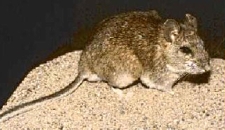Wildlife - Species

Eastern Woodrat (Neotoma floridana)
Description
The Eastern woodrat has brown-gray fur with black tips and a white underside and feet. In the summertime, adults change color to a cinnamon brown above. The woodrat’s eyes are black and large, its tail is bicolored, dark brown above and white below, and its ears are large with little hair. It typically weighs 7-12 ounces and measures 13-17 inches long, including its tail. It can be differentiated from the introduced Norway rat by its larger eyes, blunt snout, and scaleless tail.
Preferred Habitat and Biology
In the United Sates, Eastern woodrats live in much of the southeastern states and the central Midwest. They prefer deciduous forests, lowland forests, swamps, and the occasional abandoned building. In South Carolina, they inhabit the Coastal Plain and mountainous regions.
The Eastern woodrat breeds year round on the South Carolina coast. Females mate with multiple males and produce two to three litters per year, with an average of two to three young per litter. Following a 33-35 day gestation period, the female gives birth to altricial (helpless, usually blind, and lacking hair) young. After 15-21 days, young woodrats are able to open their eyes. They are weaned at 4 weeks and begin breeding the following year. Woodrats consume a variety of food including nuts, seeds, twigs, and fruit. Like other rodents, they must constantly gnaw in order to wear down their continuously growing incisor teeth. These solitary rats construct large, elaborate nests from sticks, twigs, leaves, and any other material deemed appropriate. Commonly referred to a "pack rats," they are well known for their habit of collecting shiny objects, such as coins, bottle caps, and pins.
Species Significance
Woodrats play an important role as prey in the ecological community. Many carnivores such as raptors, snakes, foxes, wolves, and bobcats utilize the woodrat as a food source, making it an integral part of the food web. The Eastern woodrat is not currently an endangered species.
References
Golley, F.B. 1966. South Carolina mammals. Charleston Museum, Charleston, SC.
Webster, W.D., J.F. Parnell, and W.C. Biggs. 1985. Mammals of the Carolinas, Virginia, and Maryland. University of North Carolina Press, Chapel Hill, NC.
Whitaker, J.O. 1980. The Audubon Society field guide to North American mammals. Alfred A. Knopf, New York, NY.
